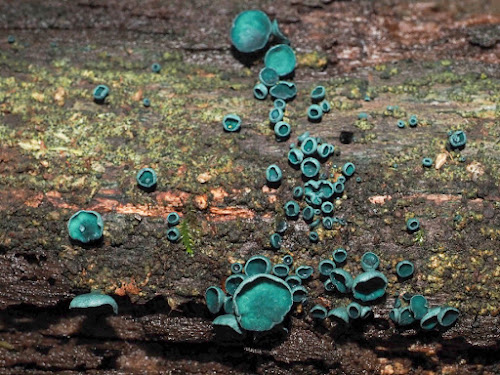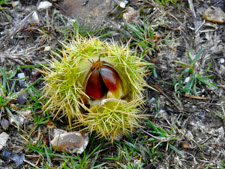The rain did not deter the hardy souls who set out from Eyeworth gunpowder mill pond in search of fungi, we weren’t to be disappointed. The woodland here is typically New Forest mature deciduous woodland with an understorey of Holly. There are many fallen, dead and decaying trees and branches leading to an environment conducive to a successful fungi foray. We spent over an hour there keeping relatively dry and managing to see many different species.
 |
Burgundy-drop
Bonnet © Sue Skarstein |
 |
Candlesnuff © Richard Smith |
These included Burgundy-drop Bonnet, Oakbug Milkcap, Holly Speckle, Porcelain Fungus, Candlesnuff, Clustered Bonnet, Blusher, Pale Oyster, Common Puffball, Purple Jellydisc, Sulphur Tuft, Beechwood Sickener, Russet Toughshank, Buttercap, Southern Bracket, and False Deathcap. We also found the fruiting bodies of Green Elfcup; a fungus that stains its substrate wood green which has been used as a decorative inlay in furniture making where it’s known as Tunbridge ware. There were so many fungi to see that we could have spent the whole of the walk in the woods.
 |
Green Elfcup © Sue Skarstein |
By the time we left the woods the rain had stopped and the sun had come out, so we joined the path for a short distance before heading out onto the heath and heading uphill where we saw four small herds of Fallow Deer grazing. We were very excited to see Nail Fungus, a localised species only found on the old droppings of ponies.
 |
| Nail Fungus © Richard Smith |
On the heath we also saw a small number of Blackening Waxcaps, whilst overhead a Red Kite gave us a beautiful view as it circled above before flying off towards the north-east. There were flocks of Redwing and Fieldfare and a Jay was heard. Devil’s-bit Scabious continued to flower, although very low to the ground, and surprisingly
 |
| Devil's-bit Scabious © Sue Skarstein |
Bilberry was seen flowering, maybe confused by the unseasonal weather. The wire-wool looking lichen Cladonia portentosa lit up some of the small mounds that are scattered across the heath. Resting on one of these mounds was the migrant micro-moth Rush Veneer which is usually seen between May and the autumn and is particularly common this year.
Ruch Veneer - a migrant micro-moth © Richard Smith
We were back in the woods at the top of the hill when someone reminded us about a tea stop, unfortunately all thoughts of bringing biscuits had been forgotten! We stopped by a fallen tree where amazingly a camera lens Sue had turned the house upside down searching for the previous night was found, fortunately it had been in a bubble wrap bag so had kept dry.
 |
Black Bulgar © Richard Smith |
There were more fungi to be seen, with dense clusters of the dreaded Honey Fungus, swarms of Black Bulgar, the easily recognised Fly Agaric, Beefsteak, Glistening Inkcap, Small Staghorn and others that we were unable to identify. Apart from fungi there was Butcher’s Broom with some nice red berries; also the inosculation of an Oak and a Beech tree, they had grown wrapped around each other, sometimes known as ‘husband and wife’ trees. Beech trees, having thin bark, are frequent conjoiners. In a field near the gunpowder factory stables a Grey Wagtail was on the ground.
Back at the pond there were several dragonflies moving too quickly to allow specific identification. We had a lovely sighting of a preening Kingfisher and also of the numerous small birds hoovering up seeds that had been put down by people these included Nuthatch, Marsh and Coal Tits A&SS












%2020191119_011.JPG)